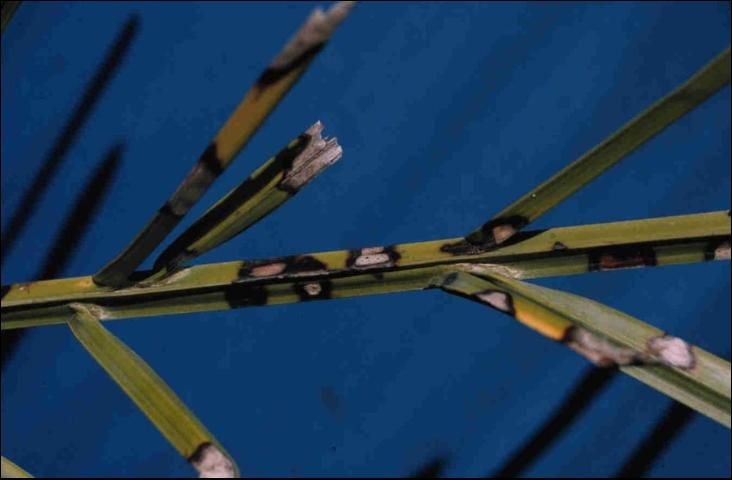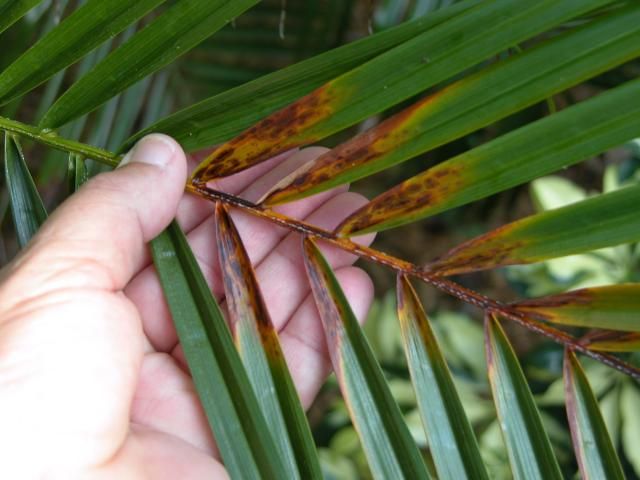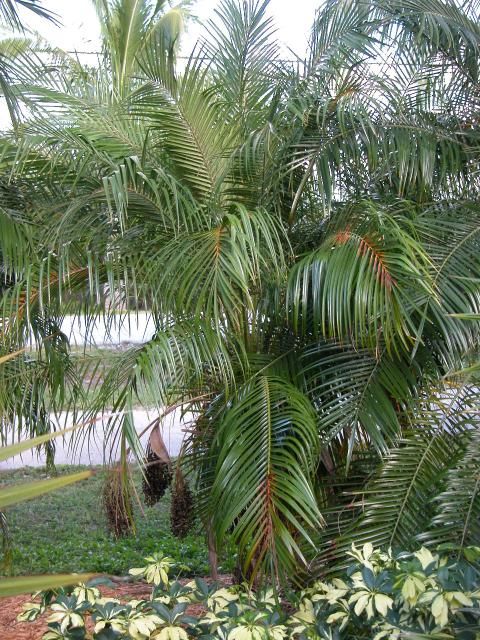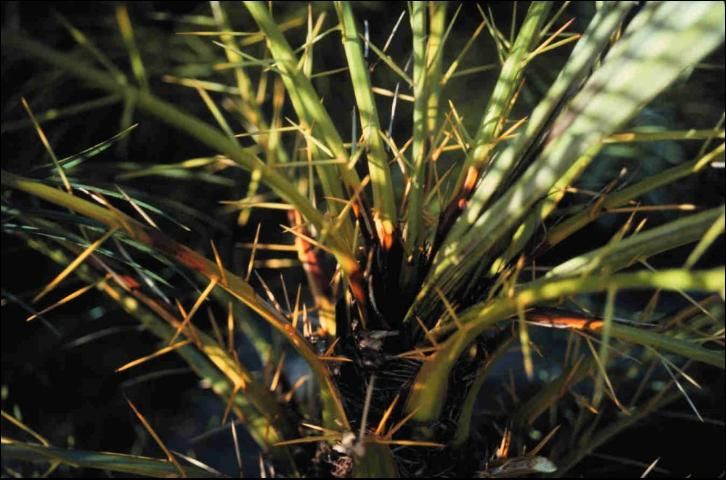Summary
-
Pestalotiopsis is a fungus that causes diseases of both the palm leaf petiole and leaf blade, often at the same time. Palm leaf diseases caused by Pestalotia are the same as those caused by Pestalotiopsis.
-
Many palms are hosts to these fungi. However, the disease is often observed in Florida on Phoenix roebelenii (pygmy date palm), where it can cause a fatal bud rot.
-
Leaf spots will begin as very small, yellow, brown or black spots that enlarge in size. The spot usually turns gray with a black outline. Lesions on the petiole and rachis are similar.
-
Symptoms may occur on multiple leaves at once, especially on juvenile palms.
-
Sanitation and water management are critical for disease management, especially in a nursery (both container and field). Injury prevention and good palm nutrition are part of the overall management strategy.
-
Fungicides may be useful as part of an integrated management program, but they should never be the sole component of a program.
Introduction
The fungus Pestalotiopsis causes leaf spots, petiole/rachis blights and sometimes a bud rot of palms. In other words, unlike the other leaf spot and petiole blight pathogens, which attack either the leaf blade or the leaf petiole, Pestalotiopsis attacks all parts of the leaf from base to tip. It is also one of the more ubiquitous fungi in the palm canopy, and is easily isolated from healthy palm tissue.
For information on other leaf spots and petiole/rachis blights, refer to the following documents: Leaf Spots and Leaf Blights of Palm at https://edis.ifas.ufl.edu/pp142; Petiole/Rachis Blight of Palm at https://edis.ifas.ufl.edu/pp145; and Calonectria (Cylindrocladium) Leaf Spot of Palm at (https://edis.ifas.ufl.edu/pp302).
Pathogen and Hosts
Pestalotiopsis palmara is the primary, but not the only, Pestalotiopsis species associated with palms. References in the literature to Pestalotia are probably the same disease, as it is difficult to distinguish between these two genera of fungi.
As indicated previously, Pestalotiopsis can be readily isolated from healthy palm tissue. The fungus is not host specific, and has been isolated from a wide variety of palms.
It has been demonstrated that the fungus usually requires wounds for the plant penetration (infection) necessary for disease development. It is not uncommon to isolate Pestalotiopsis and another pathogen from the same diseased tissue. In most cases, it is likely the other pathogen was the primary pathogen (the fungus that invaded the healthy plant tissue first), and Pestalotiopsis invaded via the wound created by the primary pathogen. In Elaeis guineensis (African oil palm), it is well-documented that insect damage is necessary for disease development.
Symptoms
Disease development by Pestalotiopsis can be restricted to only the leaf blade (leaflets or leaf segments) or only the petiole and rachis; or, it can develop on both tissues at the same time (Figure 1). Spots will begin as very small yellow, brown or black spots. If the disease is restricted, the spots may never be more than 1/4 inch in size. Under optimum environmental conditions, the spots may expand and increase in number until they merge (coalesce) to form a leaf blight or rachis blight (larger area of affected tissue) (Figure 2 and 3). Often, the spots turn a grayish color that are outlined in black. The same type of lesions occurs on the petiole or rachis of the palm. One may even see lesions occur on leaf spines.

Credit: T. K. Broschat, UF/IFAS

Credit: M. L. Elliott, UF/IFAS

Credit: M. L. Elliott, UF/IFAS
If the pathogen is restricted to only causing leaf spots, the disease may not be very damaging to the palm, especially a mature palm in the landscape. However, with juvenile palms that have no trunk and only a few leaves, the palm could be severely affected by the leaf spots.
If the pathogen is causing a rachis or petiole blight, the disease is a more serious problem for two reasons. First, as the pathogen destroys tissue in the rachis or petiole, it will affect the vascular tissue, which in turn affects tissue in the leaflets or leaf segments. Second, if the pathogen has infected the spear leaf or other younger leaves, it may spread down the rachis or petiole to the apical meristem (bud) region and affect the growing point of the palm.
While all palms are probably susceptible to diseases caused by this fungus, pgymy date palm (Phoenix roebelenii) appears to be affected quite often in Florida, especially during the winter months. With these palms, a bud rot has been observed that can kill the palm (Figure 4). This has been observed on juvenile and mature palms.

Credit: T. K. Broschat, UF/IFAS
Diagnosis
The exact diagnosis of Pestalotiopsis diseases is based on identification of the fungal pathogen. The pathogen is identified by examining the fungal spores. These may be examined directly on the plant tissue if spores are being produced, or by placing the diseased tissue in a moist chamber to induce sporulation. Isolation of the pathogen can be made on artificial media, and this growth then induced to sporulate.
It is not uncommon to observe or isolate more than one potential pathogen from the same diseased tissue. In some cases, it is apparent which fungus was the first pathogen to invade the healthy tissue, while the second fungus moved into the resulting necrotic (dead) tissue as a saprobe.
The Florida Extension Plant Disease Clinic (FEPDC) network is available for pathogen identification. Contact your local UF/IFAS Extension office or FEPDC for details on sample submission and cost of a laboratory diagnosis.
Disease Management
Pestalotiopsis produces abundant spores that can be easily dispersed by wind and water movement (splashing from rain or irrigation), so sanitation and water management are critical. Wounds or plant damage often seems to be a prerequisite for disease development, either naturally or from insects, other pathogens, nutrient deficiencies or human activity.
Water management requires limiting the length of time when the leaves are wet or exposed to high humidity levels. This includes elimination of overhead irrigation or irrigating in the early morning hours when dew is already present. Leaf wetness can also be decreased by increasing air circulation and increasing plant spacing.
In a nursery situation, severely diseased leaves should be pruned and destroyed to reduce spores available to infect healthy tissue. If the palm is small with only a few leaves, eliminate the palm completely.
In the landscape where nutrient deficiencies are often problematic, pruning diseased leaves may make the deficiency worse. Thus, one needs to decide which is or will debilitate the palm most—the disease or the nutrient deficiency. In many situations, the nutrient deficiency causes chlorosis (yellow) and necrosis (death) of the leaf tissue, creating the wound necessary for Pestalotiopsis infection. By eliminating the deficiency symptoms, one prevents disease development also. Thus, proper nutrient management is critical for disease prevention and management.
While fungicides may be useful to prevent further spread of the disease, they are merely a supplement to water management, sanitation, injury prevention and good palm nutrition. Fungicides alone will not solve the problem. It is critical to understand that fungicides do not cure the leaf spot or petiole blight already present. Once a leaf spot or petiole lesion occurs, it will remain for the duration of the life of that leaf. Fungicides are used to prevent further spread of the disease by protecting leaf tissue that has not been infected by the fungal pathogen.
In the nursery situation, prune severely diseased leaves prior to fungicide application. These leaves need to be removed anyway, and this will reduce the amount of fungicide used in the process. In the landscape situation, unless the leaf spot disease is severe, leaf pruning is not recommended unless the palm is free of nutrient deficiencies. In general, nutrient deficiencies are far more debilitating to the landscape palm than leaf spot diseases.
Fungicide trials to examine efficacy of these products on palms have not been extensive. Foliar application of broad-spectrum fungicides would be suggested. Refer to https://edis.ifas.ufl.edu/pp154 for a list of fungicides that may be used in the landscape. Fungicides must be applied according to the label.
Selected Reference
Uchida, J. Y. 2004. Pestalotiopsis diseases. Pages 27–28 in: Diseases and Disorders of Ornamental Palms. M. L. Elliott, T. K. Broschat, J. Y. Uchida, and G. W. Simone, eds. American Phytopathological Society, St. Paul, MN.